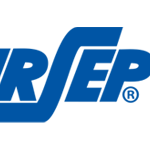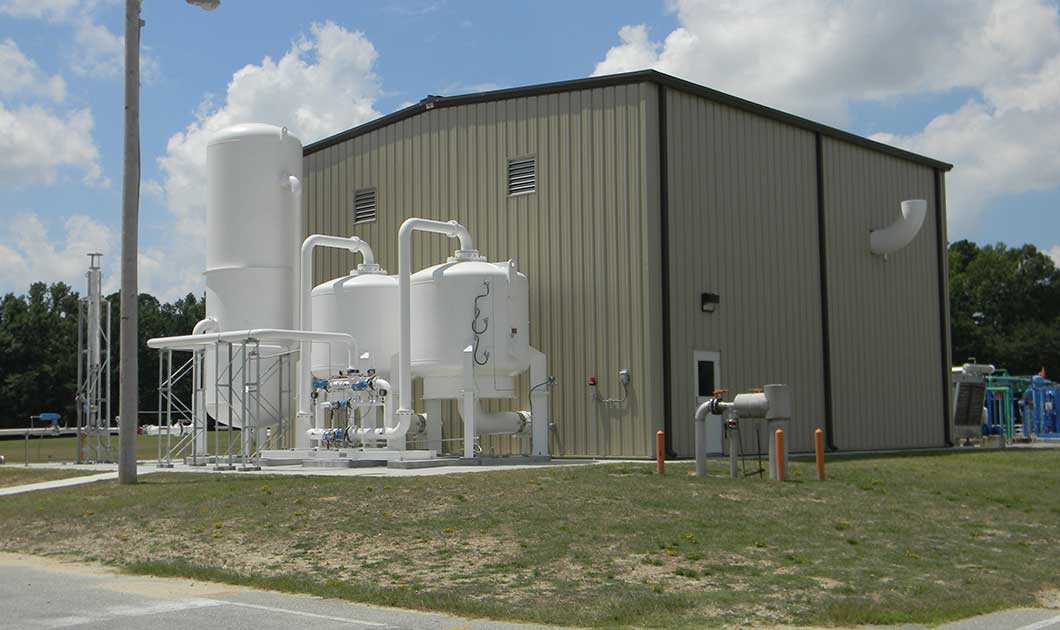
Buffalo, NY, October 1, 2013 – Management at a 21 MGD wastewater treatment plant (WWTP) in Rocky Mount, NC reports saving over 65% of electric power costs for oxygen production by replacing a cryogenic plant with a custom-engineered vacuum pressure swing absorption (VPSA) system. The move was spurred by reduced input and increased power costs for the WWTP’s pure oxygen, biological nutrient removal (BNR)-type activated sludge system.
“The new VPSA system is costing us only $345/day for electricity, compared to over $1000/day with the cryo plant,” said Kirk Bass, superintendent of wastewater treatment. “When you go with a new process, you always hope for the best. This one has not only paid off, but has done so as quickly as they promised.”
Bass said the keys to the power savings with the new 27 ton/day unit, installed last February, were idle time and turndown options that were not available with the cryogenic plant. In addition, he was able to get a unit customized to the tonnage needed, rather than having to select from available increments.
“The cryo not only couldn’t idle, it didn’t offer a turndown,” he recalled. “You had to run its motor wide open, with no way to cut back, and half to two thirds of the oxygen discharged as excess to the atmosphere. We had the benefit of power at a very reasonable price, but eventually we had to look at shutting it down.”
“Now we can get idle time and turndown automatically for the new system’s motor, and easily go in and change them as needed. The new system also stores data for a three day period, so that if we have any problem, we can download it for evaluation ourselves, or jointly with the system manufacturer. They helped us through construction and startup, and sent a trainer to spend two days with us. He did a very good job teaching us troubleshooting.”
The custom-engineered VPSA oxygen system was manufactured by AirSep Corporation of Buffalo, NY, who worked closely with plant management and staff on oxygen generated versus oxygen needed. As a result, the system includes a 22-second idle feature. It also provides for fully automatic and unattended operation, including turndown capability from 100% to 0% flow capacity, and remote monitoring by AirSep engineers.
“It’s a real user-friendly system, and easy to go in and make changes,” Bass said. “When we had an episode where our D.O. dropped and we needed a little more oxygen, we called on them for help, and they were back to us in an hour. They told us to simply lower the idle time to 20 seconds, and our D.O. was back to normal within a day.”
Replacement of Previous Oxygen Plant
Oxygen is needed for the 21 MGD, Grade 4 WWTP’s pure oxygen, biological nutrient removal (BNR)-type activated sludge system, which is followed by tertiary filtration, chlorine disinfection, dechlorination, and post-aeration. Removed solids are processed by dissolved air flotation and anaerobic digestion before pasture land application.
While the population served has increased since the plant’s 1983 startup, flow has decreased due to the closing of most of the local textile plants, and it now averages only 10-12 MGD.
“We used to average over 15 MGD, and high flows would approach the permitted 21 MGD,” Bass recalled. “We pumped as much oxygen as possible into the basins. Pressure transducers showed 1 in. of water, with the vents wide open. Now the vents are pretty much closed off and the pressure is 0.1 in. or less.”
“We had been successful lowering our oxygen costs by 15% by switching to LOX for awhile, but when energy costs started going up, our director of water resources, Wayne Hollowell, allowed us to engage a local consulting engineering firm, The Wooten Company, to work with myself and our wastewater engineer, Jim Connolly, to evaluate alternatives, including VPSA, and follow through to implementation. We originally thought the payback on the VPSA would be 7 years, and we are on track to see it at least that fast.”
Charles Davis, project manager at Wooten, based in Raleigh, NC, noted that the projected energy savings via the VPSA option helped to fund the project.
“We were able to get a $500,000 grant from our North Carolina Energy Office that was tied to the American Recovery and Reinvestment Act (ARRA),” he recalled. “The remaining funding was from our state‘s Infrastructure Finance Section, a revolving loan at 0% interest.”
Davis said that after following an RFP vendor selection process, the choice of AirSep was based on more than just cost.
“Proposals had to show benchmarks for system turndowns of 40-50%, and they were able to produce that,” he said. “As it turned out, they were able to perform even greater than expected in that regard.”
“In addition, they were very helpful by providing equipment and fabrication drawings up front, through their Terry Daniel, who also assisted later in training plant operators in maintenance and troubleshooting, as well as with plant startup,” he continued. “And their Jim Hitro worked closely with us to achieve a seamless transition from the former oxygen system to the new one.”
“Shankar Mistry, Wooten’s senior process engineer, provided valuable insight in our preparation of detailed design plans and specifications around AirSep’s proposal, and Ralph Mobley was the construction contract administrator. H.G. Reynolds Company of Henderson, N.C. was the construction contractor for the installation. We also knew Dan Gay from previous projects as an oxygen generation expert, and were very glad to have him available to our team as a consultant, including input on drawings and on site.”
Davis also noted further benefit he expected his client to derive from the new system.
“The former system had large motors and considerable instrumentation and controls, and operators had to attend to it daily, babysitting it during multiple shifts each day,” he said.
“The new system has freed up operators for other tasks, and I’m looking forward to seeing further savings result from that.”
“Our client is already exceptionally pleased, and has told us so in no uncertain terms.”
Dan Gay’s DWG Associates of Cumming, GA was the high-purity oxygen consultant to the City of Rocky Mount. His company assisted Wooten with the preparation of specifications for replacement of the old cryo plant with the state-of-the-art VPSA oxygen generator.
Custom-Engineered VPSA System
“The treatment plant was running off of LOX for quite some time since the cryo plant had been down, but that didn’t present any special challenge,” noted AirSep’s project manager, Jim Hitro. “With our own plant design philosophy calling for minimizing complexity, and our extensive and diversified VPSA installation experience available to us, including replacing cryo plants, we were readily able to provide what their consulting engineer referred to as a seamless transition.”
“What once took 20 foot-long control panels, with hundreds of wires and multiple control stations, is today replaced by a shoe box-size PLC. The cryo plant’s high speed turbines and compressors have been replaced by simple low speed blowers.”
Terry Daniels, VPSA engineering manager, said the company’s design philosophy also allowed for an easy understanding of the entire VPSA operation by the plant personnel now responsible for the new system.
“The entire VPSA plant is turned on or off with the touch of a button, and the operator interface graphically displays real time plant operation information in a user friendly display format,” he said. “The interface also collects and stores all operating data for trending, as well as for ease of trouble shooting if required.”
“Operators are able to easily identify potential issues before they become a problem. In the unusual case where a plant operator needs additional assistance to identify the source of a problem, AirSep is readily available to remotely assist.”
“Our data collection systems operate at speeds measured in milliseconds, which allow for very precise analysis of any issue. We support VPSA plants around the world, and are able to identify the source of any operational issues in the time that it takes to receive and send an e-mail.”
AirSep’s Vice President, Lawrence Hughes, noted that the company’s custom engineering capability provided the opportunity for savings in both equipment cost and operating efficiency for its customers.
“For example, we are not limited to providing equipment based on available capacity increments,” he explained. “We didn’t have to supply, say, a 30 ton plant for a 27 ton application at Rocky Mount.”
“After our equipment is installed and turned over to our customer,” he added, “we continue to provide engineering support on an ongoing basis, at no charge, working to increase their expertise and comfort level with our equipment.”
AirSep Corporation, a division of CAIRE Inc, offers custom-engineered VPSA oxygen systems, with capacities ranging from 3,000 SCFH (79 Nm3/hr) to 115,000 SCFH (3,023 Nm3/hr), and has installations around the world representing a variety of applications.

